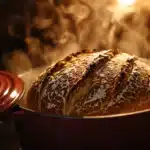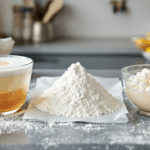For many of us, the journey into baking starts with versatile, reliable all-purpose or bread flour – the pale, predictable foundation of countless familiar loaves, cakes, and cookies. But while white flour certainly has its place, limiting ourselves to it means missing out on a vast and exciting universe of flavor, texture, and nutrition offered by whole grains and ancient wheat varieties. Venturing beyond white flour can elevate your artisan bread from simply good to truly complex and memorable.
However, incorporating these different flours can seem daunting to aspiring bakers. Whole wheat has a reputation for producing dense “worthy” loaves, rye can create sticky doughs, and ancient wheats like einkorn or spelt come with different handling requirements. Fear not! Understanding the unique characteristics of these grains and learning a few key techniques can unlock their incredible potential. This guide will encourage you to explore beyond the familiar white flour bag, introducing common whole grains and fascinating ancient wheats, discussing their benefits, and offering practical tips for successfully incorporating them into your artisan bread creations.
Why Look Beyond White Flour?
While refined white flour provides consistent structure and a neutral backdrop, whole and ancient grains bring so much more to the table:
- Flavor Explosion: This is perhaps the biggest reward. White flour offers a relatively mild taste. Whole grains, retaining the bran and germ, contribute significantly more complex flavors – think nutty, earthy, grassy, tangy, slightly sweet, or even coffee-like notes depending on the grain. Each variety has its own unique personality.
- Nutritional Powerhouse: White flour primarily consists of the starchy endosperm. Whole grain flours, by definition, include the bran (rich in fiber and minerals) and the germ (packed with vitamins like E and B complex, healthy fats, and more minerals). This makes breads incorporating whole grains significantly more nutritious.
- Textural Variety: Whole grains introduce different textural elements. They can create heartier, denser crumbs (though not always!), chewier textures, or contribute to crust complexity.
- Baking Diversity & Connection: Exploring different grains connects you to diverse global bread traditions and adds exciting variety to your baking repertoire.
Understanding Whole Grain Fundamentals
Before diving into specific grains, let’s understand why they behave differently from white flour in dough:
- The Whole Kernel: Remember the wheat kernel? It has three main parts: the outer bran layers, the nutrient-rich germ (the embryo), and the large endosperm (mostly starch and protein). White flour is milled primarily from the endosperm after removing the bran and germ. Whole grain flour includes all three parts, ground together.
- Impact on Dough:
- Hydration Needs: The bran and germ are thirsty! They absorb significantly more water than the endosperm alone. This means recipes using whole grain flours almost always require a higher hydration percentage (more water relative to flour) to achieve a workable dough consistency compared to 100% white flour recipes.
- Gluten Development: The sharp, fibrous particles of bran can physically interfere with the formation of a smooth, strong gluten network, acting like tiny blades that can cut gluten strands. This is a key reason why 100% whole grain breads are often denser than white loaves. The gluten quality also varies between different grain types.
- Fermentation: Whole grains provide more nutrients (minerals, vitamins) for yeast and bacteria, which can sometimes lead to more vigorous or faster initial fermentation. Enzymes present in the bran and germ also contribute to fermentation activity and flavor development.
- Flavor Release: More complex compounds are present in the whole kernel, which are released and transformed during fermentation, leading to deeper flavors.
- Shelf Life (Flour & Bread): The oils present in the germ make whole grain flours prone to becoming rancid more quickly than white flour. Store them in airtight containers in a cool, dark place, ideally the refrigerator or freezer, for longer life. However, breads baked with whole grains often stay moist and fresh slightly longer due to higher water absorption and fiber content.
Common Whole Grains for Artisan Bread
Let’s look at some popular choices easily found in many stores:
Whole Wheat Flour
The most common whole grain alternative.
- What It Is: Flour milled from the entire kernel of modern wheat, typically hard red wheat (more robust flavor) or hard white wheat (milder flavor).
- Flavor Profile: Distinctly nutty, sometimes slightly grassy or earthy, with a noticeable “wheaty” character. White whole wheat offers a much milder flavor, closer to white flour but with whole grain nutrition.
- Baking Properties: Absorbs a lot of water (needs higher hydration). The bran interferes with gluten development, often leading to a denser, tighter crumb compared to using only white bread flour. Works beautifully when blended with white bread flour – start by replacing 15-30% of the white flour with whole wheat and gradually increase as you get comfortable. Benefits greatly from techniques like autolyse (pre-soaking flour and water) to fully hydrate the bran and kickstart enzyme activity, and often requires thorough mixing/kneading or longer fermentation to develop adequate structure.
- Varieties: Standard (from red wheat), White Whole Wheat, variations in grind (fine, medium, coarse).
Rye Flour
A staple in Northern and Eastern European baking, known for its unique character.
- What It Is: Milled from rye grain. Rye does contain gluten-forming proteins, but they create a much weaker, stickier, and less elastic network compared to wheat gluten. Rye is also high in pentosans, complex carbohydrates that absorb large amounts of water, contributing to its characteristic stickiness.
- Flavor Profile: Offers a unique flavor spectrum ranging from mildly tangy and earthy (light rye) to deeply robust, tangy, almost fruity (dark rye). It adds a distinct complexity that wheat alone doesn’t possess.
- Baking Properties: Creates notoriously sticky doughs that can be challenging to handle. Absorbs significant water, contributing excellent moisture retention and keeping quality to breads. Its weak gluten structure means rye flour is almost always blended with a significant portion of higher-protein wheat flour (like bread flour or high-gluten flour) when aiming for lighter, taller loaves. 100% rye breads are typically very dense, moist, and compact (like traditional German pumpernickel). Rye flour also has high enzymatic activity, which can accelerate fermentation.
- Varieties: White Rye (mostly endosperm, mildest flavor), Medium Rye (some bran/germ), Dark Rye (more bran/germ, stronger flavor), Pumpernickel Meal (often very coarsely ground whole rye).
Spelt Flour
An “ancient grain” that’s a relative of modern wheat, gaining popularity for its flavor and perceived digestibility.
- What It Is: An older variety of wheat. It contains gluten, but its structure is different from modern bread wheat – it’s generally considered more fragile and highly water-soluble.
- Flavor Profile: Offers a pleasant, mildly sweet, nutty, and slightly earthy flavor. Many find it less assertive or “grassy” than standard whole wheat.
- Baking Properties: Absorbs water well. Its gluten develops quickly but can also break down easily with over-mixing or over-kneading, leading to a slack, weak dough. Requires gentler handling and potentially shorter mixing times compared to modern wheat. Often substitutes well 1:1 by weight for whole wheat flour in recipes, typically yielding a slightly lighter texture and milder taste. Available as whole spelt flour or light/sifted spelt flour (bran/germ removed).
Exploring Ancient Wheat Varieties
Beyond spelt, other fascinating ancient or “heritage” wheat varieties are becoming more available to home bakers, each offering unique flavors and baking characteristics. Note that while some people with non-celiac wheat sensitivities report better tolerance to these grains, they all contain gluten and are not suitable for individuals with celiac disease. They often have weaker or different gluten structures than modern bread wheat, requiring adjustments in handling.
Einkorn
Considered the oldest known form of cultivated wheat, dating back thousands of years. It has the simplest genetic structure (diploid).
- Flavor: Rich, distinctively nutty, slightly sweet taste with hints of herbs. Often has a lovely yellowish hue due to higher levels of carotenoids.
- Baking Properties: Possesses a very weak and unusual gluten structure (high in gliadin, low in glutenin) compared to modern wheat. Doughs made with high percentages of einkorn are typically quite sticky, slack, lack elasticity, and don’t develop strength in the same way. Requires very gentle handling, minimal kneading or folding, and often benefits from being baked in a loaf pan for support. Best approached by initially blending it in small percentages (10-30%) with a stronger bread flour or by using recipes specifically developed for 100% einkorn (often focusing on flatbreads, pancakes, muffins, or enriched pan loaves).
Emmer (Often called Farro)
Another ancient wheat (tetraploid), considered an ancestor of modern durum wheat (used for pasta). The term “farro” in Italy can sometimes refer to einkorn or spelt as well, but often means emmer.
- Flavor: Robust, nutty, slightly earthy, and hearty flavor.
- Baking Properties: Contains gluten that is generally stronger than einkorn’s but typically weaker and less elastic than modern bread wheat. Doughs can be extensible (stretchy) but may lack the spring-back (elasticity). Often performs best when blended with modern wheat flour for added structure in hearth loaves. Works well in rustic pan loaves, flatbreads, and pasta. Usually requires higher hydration and gentle handling.
Khorasan Wheat (Often known by the brand name Kamut®)
An ancient wheat relative, possibly originating in the Fertile Crescent. It’s a large grain with a distinctive hump (tetraploid). Kamut® is a specific, trademarked variety of Khorasan wheat known for its quality standards.
- Flavor: Prized for its rich, distinctly buttery, slightly sweet, and nutty flavor. Gives baked goods a beautiful golden hue.
- Baking Properties: Contains gluten and is often quite high in protein, but the gluten quality can be different from modern bread wheat – sometimes very extensible but potentially less elastic. Doughs are often smooth and relatively easy to handle. Works well in breads (often blended or in pan loaves), pasta, cookies, and pastries. Can often substitute for whole wheat flour, but hydration may need adjustment. Valued for both its unique flavor and nutritional profile (high in selenium, zinc, magnesium).
Tips for Baking with Whole & Ancient Grains
Ready to experiment? Keep these tips in mind:
- Start Small, Blend Gradually: Don’t go straight to a 100% whole grain loaf unless using a recipe specifically designed for it. Begin by substituting just 15-30% of the white flour in a trusted recipe with your chosen whole grain flour. See how it affects the dough’s feel, hydration needs, and the final loaf’s flavor and texture. Increase the percentage incrementally in future bakes as you gain confidence.
- Up the Hydration: Remember, whole grains are thirsty! You will almost certainly need to increase the water content compared to the original white flour recipe. Add extra water gradually during mixing until the dough reaches a consistency that feels pliable and slightly sticky, but not overly stiff or dry. Don’t be afraid of a wetter dough than you might be used to with white flour.
- Consider an Autolyse: This simple step can make a big difference, especially with whole grains. Combine just the flour(s) and water(s) from your recipe and mix gently until no dry bits remain. Cover and let it rest for 20-60 minutes before adding the salt and leaven (yeast or starter). This allows the bran and germ to fully hydrate, softens the bran, kickstarts enzymatic activity, and makes the dough more extensible and easier to handle later.
- Adjust Mixing/Kneading: Be mindful of the specific grain’s gluten properties. Gentle handling (stretch and folds) is often best for weaker gluten grains like spelt or einkorn. Standard whole wheat might benefit from thorough kneading to develop structure, but avoid overheating the dough.
- Manage Expectations (Especially Crumb): Breads with a high percentage of whole grains will naturally have a denser, tighter crumb than typical white artisan loaves. Don’t expect huge, airy holes right away. Focus on achieving great flavor and a pleasant, moist texture first. Good fermentation, adequate hydration, and proper handling will help maximize openness over time.
- Combine Flours for Complexity: Don’t be afraid to mix and match! Blending white bread flour with whole wheat and a bit of rye, or adding a small percentage of einkorn to your favorite sourdough recipe, can create incredibly unique and layered flavor profiles while balancing structural needs.
- Store Flour Properly: Protect your investment! Store whole grain and ancient wheat flours in airtight containers in the refrigerator or freezer to prevent the oils in the germ from going rancid, which can impart bitter, off-flavors.
Conclusion: A World of Flavor Awaits
While white flour provides a reliable foundation, the true heart and soul of artisan baking often lie in the diverse characteristics of whole and ancient grains. Stepping beyond standard white flour opens up a rewarding landscape of complex flavors, enhanced nutrition, varied textures, and deeper connection to baking history.
Don’t be intimidated by the unique properties of whole wheat, rye, spelt, einkorn, emmer, or Khorasan wheat. Approach them with curiosity and an experimental spirit. Start by incorporating small amounts into your favorite recipes, remember to increase hydration, consider gentler handling methods or techniques like autolyse, and pay attention to how the dough feels and tastes. By embracing the world beyond white flour, you’ll not only expand your baking repertoire but also craft loaves with significantly more character, depth, and nutritional value.







